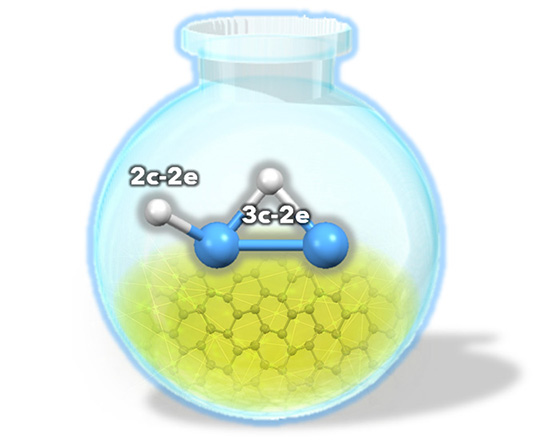- Home
- > Research
- > Research Highlights
- > Vol. 58 New Insights into Structure of・・・
 Research Highlights
Research Highlights
[Vol. 58]
New Insights into Structure of Layered Hydrogen Borides
A team of MANA researchers has determined the structure of a layered hydrogen boride synthesized via a soft chemical route. The team found that the structure consists of B-H-B bridging bonds and B-H terminal bonds, and the local structure induces macroscopic amorphous nature by “geometrical frustration.” Since the layered hydrogen boride is electrically conductive, the finding points the way toward new applications.

The team determined atomic arrangements in the layered hydrogen boride by using pair-distribution functions (that is, the probability of finding two atoms separated by a certain distance in the material). It found that the material mostly consisted of a corrugated B network decorated with three-center, two-electron B-H-B bridging bonds, as well as ordinary two-center, two-electron B-H terminal bonds. It was locally ordered but amorphous by diffractometry.
The team accounted for this discrepancy by positing geometrical frustration, caused by the positions of terminal B-H bonds located on one of two equivalent B atoms in the B-H-B bridging bonds.This geometrical frustration accounts for the amorphous state of the layered HB and the team dubbed this structure ‘‘frustrated hydrogen boride’’ (f-HB).
Local B-H chemical bonds in f-HB appear to govern its macroscopic structure as well as its conductivity upon adsorption of molecules. The material is electrically conductive rather than ion-conductive, and its B-H-B bonds are cleaved by the adsorption of molecules.
Because f-HB is an electrically conductive solid-state material with local functional groups that respond to chemical adsorption, these findings could open up unique functionalities of HB materials, such as HB nanosheets as potential sensing materials and catalysts.
This research was carried out by Satoshi Tominaka (Senior Researcher, Soft Chemistry Group, MANA, NIMS) and his collaborators.
Reference
“Geometrical Frustration of B-H bonds in Layered Hydrogen Borides Accessible by Soft Chemistry”
Satoshi Tominaka, Ryota Ishibiki, Asahi Fujino, Kohsaku Kawakami, Koji Ohara, Takuya Masuda, Iwao Matsuda, Hideo Hosono, and Takahiro Kondo
Journal : Chem [February 13, 2020]
DOI : 10.1016/j.chempr.2019.11.006
(Press release on this research)
"Development of a Novel Nanosheet with Adjustable Electrical Conductivity” (10 December 2019)
https://www.nims.go.jp/mana/news_room/press/2019121001.html
(MANA E-BULLETIN)
https://www.nims.go.jp/mana/ebulletin/
Satoshi Tominaka, Ryota Ishibiki, Asahi Fujino, Kohsaku Kawakami, Koji Ohara, Takuya Masuda, Iwao Matsuda, Hideo Hosono, and Takahiro Kondo
Journal : Chem [February 13, 2020]
DOI : 10.1016/j.chempr.2019.11.006
(Press release on this research)
"Development of a Novel Nanosheet with Adjustable Electrical Conductivity” (10 December 2019)
https://www.nims.go.jp/mana/news_room/press/2019121001.html
(MANA E-BULLETIN)
https://www.nims.go.jp/mana/ebulletin/
Affiliations
International Center for Materials Nanoarchitectonics (WPI-MANA), National Institute for Materials Science (NIMS), Namiki 1-1, Tsukuba, Ibaraki 305-0044, Japan
Contact information
Research Center for Materials Nanoarchitectonics (MANA)
National Institute for Materials Science
1-1 Namiki, Tsukuba, Ibaraki 305-0044 Japan
Phone: +81-29-860-4710
E-mail: mana-pr[AT]nims.go.jp
1-1 Namiki, Tsukuba, Ibaraki 305-0044 Japan
Phone: +81-29-860-4710
E-mail: mana-pr[AT]nims.go.jp

